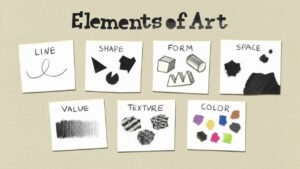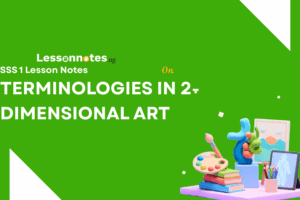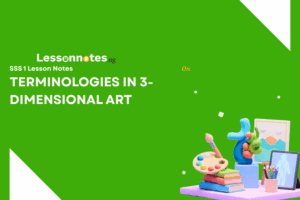Introduction To Graphics SS1 Visual Arts Lesson Note
Download Lesson NoteTopic: Introduction To Graphics

Graphic design is the art and practice of visual communication and problem-solving through the use of space, types, images and colour. It is a branch of applied arts. Graphic design is used to refer to both the process of designing and the result of an art product. Graphic design can be categorized into two:
- Still Graphics: which is related to all printed matter
- Motion Graphics: which has to do with videos and movies.
LETTERING
This also referred to as typography, is the art and technique of letter and arrangement to make written language legible, appealing and readable in-display lettering deals with the letter as seen in the alphabet A. It is the arrangement of letters in different typefaces and varied point sizes, italics or block letters in the arrangement of letters, spacing is very important to build balance in the lettering as they relate to each other.
For effective lettering, leading, kerning and tracking spaces need to be explored on different occasions for adequate construction and arrangement of letters. Kerning is the space between two specific letters or characters, tracking is the space between all letters or characters used, and leading is the line spacing used in the layout.
Block Lettering: Block lettering is characterized by letters with straight, uniform lines and angles, creating a bold and clear appearance.
INTRODUCTION TO ELEMENTS AND PRINCIPLES OF ART AND DESIGNS
The elements and principles of art and design are the elementary components of art and design used as a guide to creating works of art. Different forms of art share the use of the same concept of elements and principles. Music has form and composition that can be symmetrical or asymmetrical (like visual arts) and they occur in balance. Contrast is also common among them to evoke excitement and emotion. Though in this case, different terms would have similar meanings, there can be a difference in the use of unity and variety.
Cultural and creative-arts-oriented messages are communicated with beauty, balance and harmony through the applications of elements and principles of art in forms of artistic expression used.
ELEMENTS OF ART

Elements of art are the elementary visual components of a work of art. They are as follows: line, shape, form, space, colour, texture and value.
- Line: A line is a mark made on a surface by a moving point or dot or dots. It is an optical phenomenon of a visual part that enables the eyes to move within a work of art. It is also used by the artist to direct the eye of the viewer around the work of art.
Symbolic uses of Line
i. Straight lines signify different moods and affection;
ii. Curve lines reflect greater dynamism and flexibility;
iii. Horizontal lines give an expression of calm, tranquility, relaxation and space;
iv. Vertical lines leave an impression of height and elegance, dignity, formality, stability and strength.
v. Diagonal represents action, activity, excitement and movement.
Practical Uses Of Lines in Our Everyday Life
i. Lines are used for writing.
ii. It is used to create or define boundaries.
iii. It forms the basis for drawing and painting.
iv. It can be used as an imaginary check.
These are the basic types of lines;
i. Vertical Line: A line that moves from up to down or down to up, perpendicular to the earth, extending upwards towards the sky.
ii. Horizontal Line: This is a line that moves from right to left, or left to right, parallel to the earth.
iii. Zig Zag Line: This is a line in sharp diagonal motion in alternating directions.
iv. Diagonal Line: This line is neither vertical nor horizontal. It is an angle slanted in between the two.
v. Curved Line: This is a line that is continuously bending without an angle.
- Shape: Shape is an analyzed space defined by a or by contrast to its surroundings.
- Form: A form is the dimensional form and looks of an object or description for any three-dimensional object. The form can also be interpreted by light and dark through shading or painting.
- Space: Space is the free area between the solid objects or between shapes and other elements in a work of art. It is everywhere around us a platform for arranging objects and elements in the art of living, whether it is two-dimensional like drawing and painting or three-dimensional like sculpture and architecture.
- Texture: Texture is the perceived surface quality of a shape, form or object.
- Value: Value also referred to as tone, is the presence of light and dark shades in a work of art. Artists use it to create an illusion of depth, mass, form and three-dimensionality on a flat surface in a work of art.
PRINCIPLES OF ART
Principles of art are a mental guide that helps the artist in the proper use and distribution of the elements of art when creating a form of art. In creating a work of art, the artist determines what the centre of interest of the artwork will be.
- Balance: This is the spread or distribution of the visual weight in a work of art through the creative arrangement with the elements of art.
The three types of balance, namely: symmetrical, asymmetrical and radial. Symmetrical balance has an equal distribution of visual weight on both sides. Asymmetrical has a different visual weight size on each side at a distance that maintains balance. Radial balance is a circular balance, distributed out from a central object to maintain balance.
- Proportion: The size of one part of a work of art in comparison to its other part is called proportion. Proportion can be used to manage space, create distance, show emphasis and achieve balance.
- Movement: The use of line, color, values, textures, forms, shape and space to direct the viewer’s eye into an art piece, from one part of the piece to another is termed the movement
- Unity: This is the resultant product when the elements and principles of art are applied to create a work of art; the agreements about each other as they fit together create an overall message or impression.
- Variety: This is the use of different qualities or styles of application of art to create a desired visual effect.
- Emphasis: This is the visual reinforcement through the arrangement of the element of art towards something the artist wants the viewer to pay attention to.











